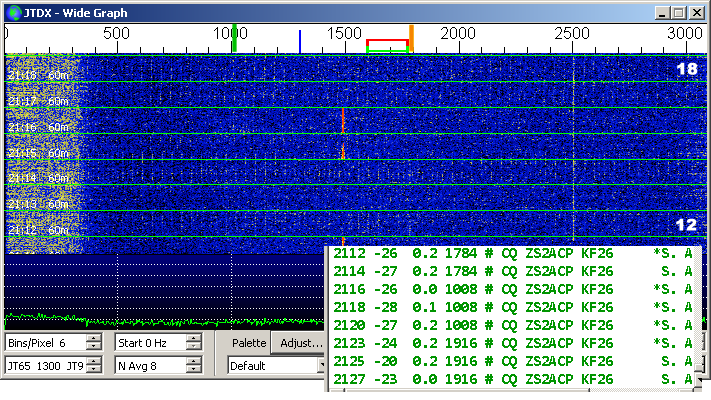It is quite obvious that the internet helps to spread news very fast and thus, a real FT8 explosion took place. On busy moments there is a myriad of stations and it is impressive to watch how good the WSJT-X software decodes the whole bunch every 15 seconds. Hats off for the developers!
The FT8 bandwidth allows many stations to use a small portion of the spectrum and the spectrum efficiency is roughly comparable with CW. A single phone channel is enough for tens of stations. If one had to write a commercial leaflet for FT8, these benefits would be prominent…
However, in line with what I said earlier, missing the “bottom dB’s” is a distinct disadvantage. Although my private schedule has been very busy and does not allow for much time for the hobby, I sometimes work in my shack with JTDX (JT65) and WSJT (FT8) running in the background, monitoring 60 m to know what is going on.
There are some observations:
- FT8 gets boring sooner
- One has to respond to a CQ with light speed and split frequency to have a chance to work DX stations
- Signal reports vary considerably
- More false decodes than JT65
- The long shots are missed
Auto sequence
My first experience with auto sequence was gained when working meteor scatter on (mostly) 70 MHz. The auto sequence feature with MSK144 is great for this mode because one transmits the correct message sooner, which increases the probability of a decode at the other end. With the short interval between RX and TX, the same applies for FT8. A distinct difference between MSK and FT8 is that MSK repeats the same message many times and even if you would advance the sequence during the first seconds of the period, the remaining transmitted messages will not be affected. With FT8, changing the message during the period will break the forward error correction. Chances of a good decode diminish quickly. This is an interesting statistical exercise by the way…
No human interaction
But because there is almost no operator interaction, you simply sit and watch. A distinct difference between meteor scatter and HF is that one has to wait for the meteor scatter pings and bursts and that is exactly why meteor scatter can be exiting whilst FT8 on HF gets boring soon.
Light speed responses to CQ required
Responding to a CQ is also challenging because you have to reply immediately. If your transmission starts too late during the period, the chances of a good decode at the other end diminish. I also noted that if a number of stations reply at the same time on the frequency of the ‘DX’ station, the interference causes problems and it is likely that nothing will be decoded. It is better to call ‘split’ frequency, but I have seen many cases where these calls jump on another QSO. Sometimes because of bad operation practice, but it can also go unnoticed that frequency is occupied, because of absence of propagation.
Signal reports
Because of the shorter intervals, the signal reports are rather inconsistent. I assume that fading and interference contribute to the differences. For propagation research, this aspect is an important disadvantage. A lot of decodes have to be averaged to get a more reliable ‘measurement’.
False decodes
I noticed that FT8 renders more false decodes than JT65. Although these can be distinguished form ‘real’ stations in many cases, because of the weird calls and grids, it is annoying because JTAlert triggers false ‘alarms’ and it also sends confusing spots to reverse beacon networks.
Missing dB’s
This is my major concern. One misses the long shots. For me, FT8 is rather frustrating. The lesser sensitivity and the limited reliability with weak signals is a distinct disadvantage. Signals are visible on the waterfall but nothing is decoded. If the same stations would use JT65, decoding would be easy. Have another look at a waterfall of very weak signals (along with QRM from an OTH radar):
The green and yellow markers on top of the waterfall mark the (JT65 sync tone) frequencies where ZS2ACP was transmitting and this illustrates how good JT65 works with weak signals. FT8 gets unreliable below -18 dB whilst all CQ’s of ZS2ACP were copied steadily with levels of about -26 to -28.
As a result, one gets blindfolded for the best DX. Destinations like 5W1, KL7, 3D2 and the like become ‘out of reach’. I am glad that stations like Tony, 3D2AG hold on to JT65.
Not all got worse
Finally, the FT8 frenzy has a clear advantage: working a rare station with JT65 is a lot easier because of the fewer stations using this mode. As said, I appreciate those who stick to the slow, but reliable mode!

